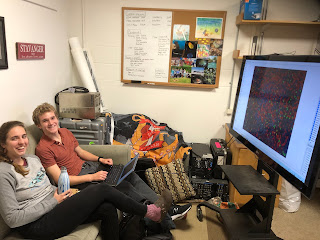Circle, circle, barnacle
Earlier this fall, I received a very exciting email. A local high school student who had worked with my lab last year wondered if I would mentor him through his science fair project again. I immediately answered yes!
My lab has a lot going on right now, so there were plenty of options to choose from. The student, Erik, is very interested in biofouling, so I decided to entrust him with a dataset from the high Arctic. As some of you might remember, Kharis successfully recovered CATAIN from its spot at 79 N last August. The camera yielded fantastic image data showing settlement and post-settlement mortality in a fouling community over 8 months. It's an incredible dataset with really exciting, novel information hidden within.
 |
| Kharis and Erik working together on CATAIN images. |
Erik was enthusiastic about the image analysis and even more excited to study a high Arctic ecosystem for his science fair project! After an initial set-up meeting at the lab, Erik worked independently at home to circle all the barnacles. He checked in with us last week, and he's making great progress!
It's immensely satisfying to guide a young student through data analysis. Erik has very clear ideas of the scientific questions he wants to answer, and Kharis and I can help him get there. I'm glad to have him involved in the lab, and hopefully, his science fair project will stand out!
Comments
Post a Comment